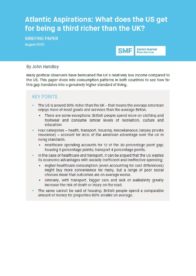Many have bemoaned the UK’s relatively low income compared to the US. This paper dives into consumption patterns in both countries to see how far this gap translates into a genuinely higher standard of living for Americans, and what the drivers of the difference in living standards are.
KEY POINTS:
- The US is around 30% richer than the UK – that means the average American enjoys more of most goods and services than the average Brit.
- There are some exceptions: British people spend more on clothing and footwear and consume similar levels of recreation, culture and education.
- Four categories – health, transport, housing, miscellaneous (largely private insurance) – account for 95% of the American advantage over the UK in living standards.
- Healthcare spending accounts for 12 of the 30 percentage point gap; housing 9 percentage points; transport 4 percentage points.
- In the case of healthcare and transport, it can be argued that the US wastes its economic advantages with socially inefficient and ineffective spending:
- Higher healthcare consumption (even accounting for cost differences) might buy more convenience for many, but a range of poor social choices mean that outcomes are on average worse.
- Similarly, with transport, bigger cars and lack of walkability greatly increase the risk of death or injury on the road.
- The same cannot be said of housing: British people spend a comparable amount of money, but American dwellings are 60% larger on average.
- Housing conditions in the UK could be improved by increasing the size and quality of the housing stock, but policymakers must address the UK’s long-running productivity underperformance to truly close the gap in living standards with the US.

DOWNLOAD THE BRIEFING: PDF
